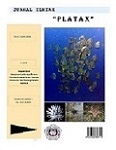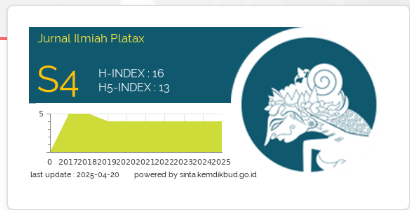The Nursery Technique of Juvenile Sandfish, Holothuri scabra
DOI:
https://doi.org/10.35800/jip.8.1.2020.28286Keywords:
Nursery, Juvenile, SandfishAbstract
Sea cucumbers are an Indonesian fisheries export commodity. Sea cucumber populations that are endangered in nature encourage sea cucumbers to be produced through hatchery and nursery. Through nursery, it is expected that sea cucumber juveniles are stronger and can increase survival rate when stocked in growth containers or restocked. This study aims to provide better sandfish nursery techniques and local area characteristics to support hatchery activities. This study was conducted in May - July 2018 at the Hatchery CV Pesona Manir Rat, Southeast Maluku Regency. Juvenile sandfish 30-36 days old, rearing in hapa measuring 100 x 100 x 70 cm with a density of 200 individuals/hapa. In one tank rearing is placed one hapa. During rearing, 100-150% of water is changed and given one-liter Navicular sp. every day. Aeration was installed 4 points on each hapa and water quality measurement was conducted every day. At the end of the study, body length measurements and mortality calculations were conducted. The result is that sea cucumber juvenile which is maintained has absolute growth ranging from 1.98 to 2.1 cm with an average absolute growth of 2.03 cm. The average mortality obtained was 53.83% with a range of 53% - 55%. Based on the discussion it was concluded that this technique can be applied in sandfish nursery.Â
ABSTRAK
Teripang merupakan komuditi eksport perikanan Indonesia. Populasi teripang yang terancam di alam mendorong teripang harus diproduksi melalui pembenihan dan pendederan. Melalui pendederan diharapakan anakan teripang lebih kuat dan dapat bertahan hidup lebih baik ketika ditebar pada wadah pembesaran atau direstoking. Penelitian ini bertujuan memberikan informasi teknik pendederan teripang pasir yang lebih baik dan berkarakteristik daerah setempat guna menopang kegiatan pembenihan. Penelitian ini dilaksanakan pada bulan Mei – Juli 2018 di Hatchery CV Pesona Manir Rat, Kabupaten Maluku Tenggara. Juvenil teripang pasir berusia 30 – 36 hari, dipelihara pada hapa berukuran 100 x 100 x 70 cm dengan kepadatan 200 individu / hapa. Pada satu bak pemeliharaan ditempatkan satu buah hapa. Selama pemeliharaan dilakukan pergantian air sebanyak 100 – 150 % dan diberikan satu liter Navicular sp. setiap hari. Aerasi dipasang sebanyak 4 titik pada setiap hapa dan dilakukan pengukuran kualitas air setiap hari. Diakhir penelitian, dilakukan pengukuran panjang tubuh dan perhitungan mortalitas. Hasilnya juvenile teripang yang dipelihara mengalami pertumbuhan mutlak berkisar antara 1,98 – 2,1 cm dengan rata-rata pertumbuhan mutlak sebesar 2,03 cm. Mortalitas rata-rata yang diperoleh sebesar 53, 83 % dengan kisaran 53 % - 55 %. Berdasarkan pembahasan disimpulkan bahwa teknik ini dapat diterapkan dalam pendederan teripang pasir.Â
References
Giri N.A., Sembiring S.B.M., Marzuqi M., dan Andamari R. 2017. Formulasi dan Aplikasi Pakan Buatan Berbasis Rumput Laut Untuk Pendederan
Benih Teripang Pasir (Holothuria scabra). Jurnal Riset Akuakultur. 12, 263-273 pp
Hair C. 2012. Sandfish (Holothuria scabra) production and sea-ranching trial in Fiji. Asia– Pacific tropical sea cucumber aquaculture, ACIAR Proceedings. Vol 136, 129–141 pp.
Indriana L. F., Afrianti Y., Hilyana S., & Firdaus M. 2016. Preferensi Penempelan, Pertumbuhan, dan Sintasan Larva Teripang Pasir, Holothuria scabra Pada Substrat Lamun yang Berbeda. Jurnal Riset Akuakultur. 11, 249-258
Indriana. L. F., Firdaus M., Suprono & Munandar H. (2017). Survival Rate and Growth of Juvenile Sandfish (Holothuria scabra) in Various Rearing Conditions. Journal Marine Research in Indonesia. 42, 11 – 18.
Kamyab E., Kühnhold H., Novais S.C., Alves L.M.F., Indriana L., Kunzmann A., Slater M., & Lemos M.F.L. 2016. Effects of thermal stress on the immune and oxidative stress responses of juvenile sea cucumber Holothuria scabra. Journal of Comparative Physiology.
Kementerian Kelautan dan Perikanan. 2015. Pedoman umum identifikasi dan monitoring populasi teripang. Direktorat Konservasi dan Keanekaragaman Ruang Laut. 75 pp
Purcell, S. (2012). Principles and science of stocking marine areas with sea cucumbers. Asia–Pacific tropicalsea cucumber aquaculture, ACIAR Proceedings. 136, 92–103. Robinson G. and B. Pascal. 2012. Sea cucumber farming experiences in south-western Madagascar. Proceedings of an international symposium, Noumea, New Caledonia. 142–145 pp.
Sembiring S.B.M., I.K. Wardana, dan Haryanti. 2016. Performa benih teripang pasir, Holothuria scabra dari sumber induk yang berbeda. Jurnal Riset Akuakultur. 11, 147-154 pp.
Sembiring. S.B.M., I N.A Giri., G.S. Wibawa., J.H Hutapea. (2017). Teknologi Pembenihan Teripang Pasir, (Holothuria scabra). Balai Besar Riset Budidaya Laut dan Penyuluhan Perikanan. Gondol. 19.
Tomatala P., Letsoin P. P & Kadmaer E.M.Y. (2017). Studi pertumbuhan teripang pasir (Holothuria scabra) pada pen-culture yang berbeda. Prosiding Inovasi IPTEK Perikanan dan Kelautan I. 613 - 621.
Tomatala P., Letsoin P.P, Ompi M., & Kadmaer E.M.Y. (2018). Size Identification of the Adult Sea Cucumber, Holothuria scabra, in the Coastal of Labetawi Village, Tual Town of Maluku Province. Proceeding The 3rd International Conference on Operations Research. 56-60.
Wang F., Yang H., Gao F., Liu G (2008) Effects of acute temperature or salinity stress on the immune response in sea cucumber, Apos- tichopus japonicus. Comp Biochem Physiol A(151):491–498
Downloads
Additional Files
Published
How to Cite
Issue
Section
License
COPYRIGHT
Authors who publish with this journal agree to the following terms:
Authors hold their copyright and grant this journal the privilege of first publication, with the work simultaneously licensed under a Creative Commons Attribution License that permits others to impart the work with an acknowledgment of the work's origin and initial publication by this journal.
Authors can enter into separate or additional contractual arrangements for the non-exclusive distribution of the journal's published version of the work (for example, post it to an institutional repository or publish it in a book), with an acknowledgment of its underlying publication in this journal.
Authors are permitted and encouraged to post their work online (for example, in institutional repositories or on their website) as it can lead to productive exchanges, as well as earlier and greater citation of the published work (See The Effect of Open Access).






































